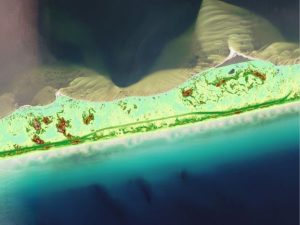11 January 2019
Barrier island sand dunes recover at different rates after hurricanes
Posted by Lauren Lipuma

An aerial view of Santa Rosa Island, Florida, a barrier island known for its beautiful beaches.
Credit: Chris Houser.
By Priyanka Runwal
Sand dunes on coastal barrier islands buffer the U.S. Atlantic and Gulf coasts from oncoming hurricanes. Every year, millions of public and private dollars fund the restoration of these barrier islands, but managers often focus on the recovery of smaller sand dunes and aim at making them bigger, for better storm protection.
But new research presented at the 2018 AGU Fall Meeting last month finds sand dunes on these barrier islands don’t all recover at the same rate. Small dunes go back to becoming small dunes; large dunes recover to be large dunes; and they don’t typically grow larger than they were before the storm struck.
Chris Houser, a coastal geologist at the University of Windsor, Canada who presented the findings, experienced Hurricane Ivan the day after he’d arrived in Pensacola, Florida in 2004. Houser witnessed the damage caused to barrier islands along Pensacola and loss of dune fronts, which motivated him to study the sand dune recovery process in the aftermath of storms.
“We wanted to know how quickly narrow sections of the island recover compared to wider sections with bigger dunes,” he said.
Recent research has found that dunes can take up to 10 years to recover to their pre-storm heights. In the new study, Houser’s team wanted to see how dune recovery varied for dunes of different sizes.
The researchers surveyed five barrier islands affected by Hurricane Ivan – Santa Rosa and Saint George Islands in Florida, Assateague Island in Maryland and Follets and Galveston Islands in Texas. They compared three-dimensional maps of these islands between 2004 and 2010 – encompassing data just before the hurricane and after. Using these maps, the researchers measured the heights of dunes closest to the sea and then assessed the change in dune height following the storm.
They found when storms hit small dunes, the sand gets deposited in a fan shape to the back of the dunes. In the case of large dunes, sediments get transported to the near shore.
“The recovery of the smallest dunes was exceptionally fast,” Houser said. “There isn’t that much sand to be brought back.” Islands like Santa Rosa and Assateague, which have relatively small dunes, recovered rapidly after the hurricane. But once these recovered there was no more sand left, according to Houser. “You started off as small dunes and recovered fast as small dunes,” he said.
In the case of larger dunes, the wind brings back the near shore sand, but this back-migration takes time. “It’s a slower recovery, but you get your bigger dunes back,” Houser said. Vegetative remnants in the form of a seed bank and underground plant stems also help vegetation reestablish and stabilize these large dunes after the storm.
But it’s the mid-sized dunes that showed the slowest recovery. When storms strike these dunes, some sand is transported behind the dunes, even beyond where the small-dune-sands are deposited, and some sand is laterally moved near shore. Not only does it take time for the sand to accumulate back in the pre-storm region, but almost all the vegetative remnants in the sand are lost and take a long time to come back, according to Houser.
“This is the 1 to 1.5 meters (3 to 5 feet) dune height below which you’re probably going to continue to get smaller and smaller dunes because they can be easily taken out by the next storm surge,” Houser said.
If hurricanes become more frequent or intense in the coming years, dunes may be forced into a lower recovery height, Houser said. Also, anthropogenic activities like construction and heavy footfall along the shorelines can accelerate dune height variability along the shoreline, creating many smaller dunes. With more and more sand getting pushed behind the dunes post-storms, there will be little sand available for recovery and the shoreline is likely to retreat.
“A lot of the times, the thought is to restore these small dunes to make them bigger,” Houser said. “But unless you’re going to pile up a massive amount of sand and put some new vegetation, it’s not going to work.”
He suggests saving bigger dunes, as they supply sand to adjacent sites.
Priyanka Runwal is a science communication graduate student at UC Santa Cruz.










 GeoSpace is a blog on Earth and space science, managed by AGU’s Public Information staff. The blog features posts by AGU writers and guest contributors on all sorts of relevant science topics, but with a focus on new research and geo and space sciences-related stories that are currently in the news.
GeoSpace is a blog on Earth and space science, managed by AGU’s Public Information staff. The blog features posts by AGU writers and guest contributors on all sorts of relevant science topics, but with a focus on new research and geo and space sciences-related stories that are currently in the news.